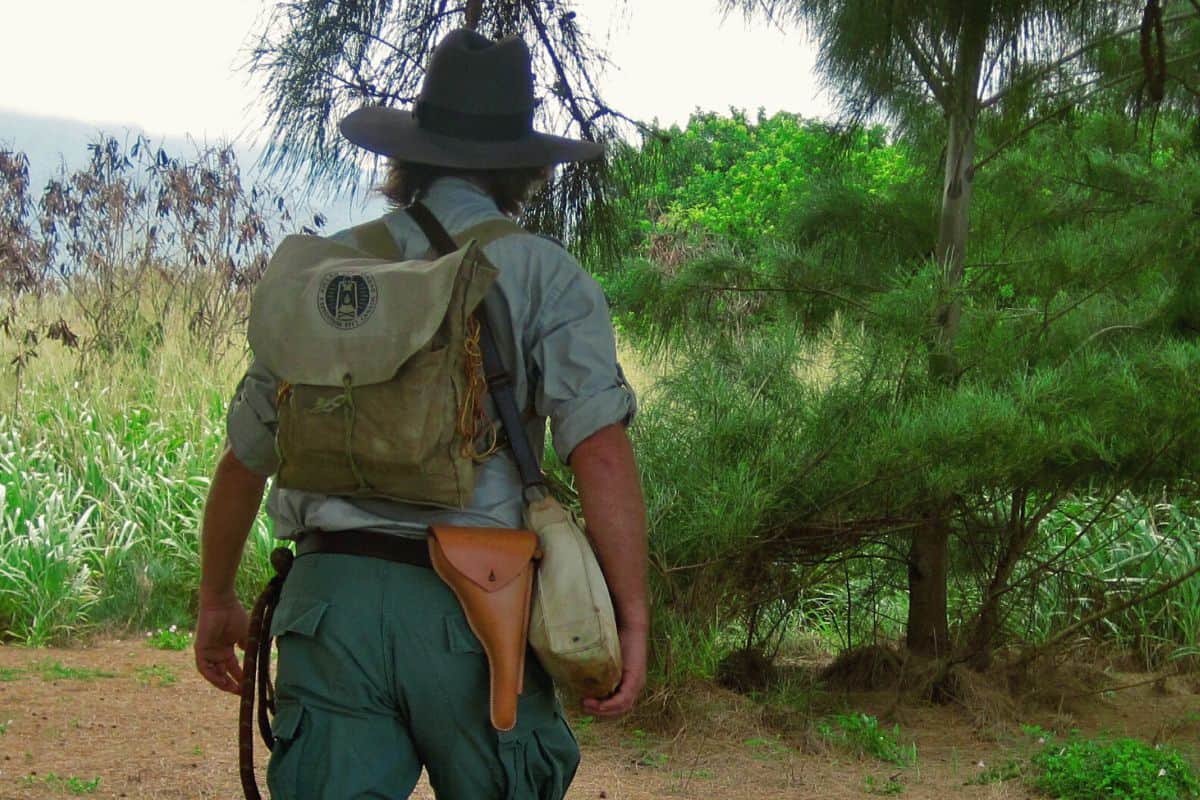Spending the duration of your hike hauling your pants up because of an ill-performing belt is no fun at all. Nor is enduring hour after hour of chafing, digging in, and general discomfort that can be caused by wearing a leather belt that’s better suited to a day in the office than a day on the trails.
To help you keep your hips happy and hands-free during your trail time, we review eight belts, each with it’s own benefits, drawbacks and situational uses. We answer why we feel the Arc’teryx Conveyor is our pick as the top overall belt, and take you through a hiking belt buying guide explaining what features are important to consider before you buy!
Table of Contents
At a Glance: Quick Recommendations
-
Editor’s Choice:
Arc’teryx Conveyor Belt
“Sleek, low-profile, ultralight, and the most comfortable belt we tested over the course of a day on the trails.” -
Runner Up:
Black Diamond Diamond Mine Belt
“A high-quality, lightweight hiking belt that fits snugly under a climbing harness.” -
Best Budget:
Propper Tactical Duty Belt
“Cheap, durable, airport-friendly, and one of the lightest belts on our list.” -
Best Closure:
Klik Belts Tactical Belt
“More expensive than other belts on our list but a solid option for anyone who wants a belt that’s built to last a lifetime and has the convenience of a quick-release, two-ring buckle.” -
Bargain Buy:
Hoanan Tactical Hiking Belt 2-Pack
“Stretchy, airport-friendly, and very fairly priced.” -
Most Versatile:
Under Armour Men’s Webbed Belt 2.0
“A good hiking belt at a great price and stylish enough for nights on the town.” -
Best For All Occasions:
Columbia Men’s Military-Style Web Belt
“This belt works well as both hiking attire and casual wear.” -
Best For Air Travel:
JASGOOD Military & Tactical Nylon Webbing Belt
“A military-inspired belt with a non-metal buckle that will let you sail through security without having to disrobe.”
Top Choices by Category
Budget: Propper Tactical Duty Belt, JASGOOD Military & Tactical Nylon Belt, and Hoanan Tactical Hiking Belt 2-Pack
Lightweight: Arc’teryx Conveyor Belt and Black Diamond Diamond Mine
Tactical/Military: JASGOOD Military & Tactical Nylon Belt, Klik Belts Tactical, and Propper Tactical Duty Belt
What are the Best Hiking Belts?
Having trialed and tested dozens we settled on the 8 belts below as some of the best outdoor belts for hiking, backpacking, camping, and climbing.
- Arc’teryx Conveyor Belt
- Black Diamond Diamond Mine Belt
- Propper Tactical Duty Belt
- Klik Belts Tactical Belt
- Hoanan Tactical Hiking Belts 2-Pack
- Under Armour Men’s Webbed Belt 2.0
- Columbia Men’s Military-Style Web Belt
- JASGOOD Military & Tactical Nylon Webbing Belt
Arc’teryx Conveyor Belt
Editor’s ChoiceMaterial: Nylon; Metal ⸱ Weight: 3.4 ounces
The Arc’teryx Conveyor Belt is our top pick for best hiking belt, catering to a wide range of hikers, from gram-counting minimalists to casual Sunday strollers.
Despite weighing just 3.4 oz., the Conveyor is both incredibly versatile and durable. And although it can’t be cut down, it does come in three sizes. These are small (43 inches), medium (45.5 inches), and large (49.5 inches). This belt also uses a durable, self-locking stainless steel tongue buckle which is weather- and corrosion-resistant.
The breathable nylon materials used in this textured webbing belt do require a little breaking in to reduce stiffness, and the buckle is a fraction on the large side for use under a climbing harness. These minor flaws, however, seem a small price to pay for such a durable and well-made product.
PROs
- Very lightweight
- Durable metal buckle
- Abrasion-resistant fabric
- Stylish enough for casual wear
CONs
- Starts stiff
Bottom-Line: Lightweight, durable, and tough enough to last a lifetime, the Arc’teryx Conveyor is for those who like to travel light and fast without compromising on quality and comfort.
Black Diamond Diamond Mine Belt
Runner UpMaterial: Military Grade Polyester; Aluminium ⸱ Weight: 3.5 ounces
The Diamond Mine belt from Black Diamond was a close runner-up, offering both comfort and durability.
This belt is made of strong, military-grade polyester webbing and uses a hard-anodized aluminum buckle that remains flat and doesn’t catch or interfere with your layers, climbing harness, or backpack hipbelt.
We loved how this adjustable belt maintained its “barely there” feel throughout the day, how we didn’t have to stop and tighten it at any point, and its low-bulk design. We were also pleased with the option of four different colorways because we reckon there’s a chance we’ll be picking up another one sometime soon!
PROs
- Weighs just 3.5 oz.
- Tough materials
- Low-profile sturdy belt buckle
- 4 colorways
CONs
- Stiff when new
Bottom-Line: A lightweight but durable belt that provides all-day comfort. What’s not to love?
Propper Tactical Duty Belt
Best BudgetMaterial: Nylon; Plastic buckle ⸱ Weight: 4.8 ounces
The Propper Tactical Duty Belt is a steal for those needing a cheap yet durable solution to their outdoor pant-supporting needs.
The Propper is made with an all-nylon fabric strap and a non-metallic tongue buckle. While this buckle is a little less durable than metallic options, its light weight and airport-friendliness make it a good option for world travelers and gram-counters alike.
What we like most about this nylon belt is its simplicity and lack of breakable parts. The one-piece molded belt buckle is easy to thread and adjusts with just one hand, but holds even heavily loaded pants in place even when you’re removing fast and jostling around on the trail.
The Propper comes in many sizes with multiple color options. And if you don’t get your size just right, you can easily trim the length to suit.
PROs
- Low price tag
- Multiple sizes
- Travel-friendly
CONs
-
Flat plastic buckle is not as durable
-
Bottom-Line: This highly affordable belt for hiking pants isn’t the most durable, but its light weight, comfort, and convenience make it a solid choice nonetheless.
Klik Belts Tactical Belt
Best ClosureMaterial: 100% Nylon; Aluminum alloy ⸱ Weight: 8 ounces
The Klik Belts Tactical features a quick-release buckle closure, ideal for fast, easy, and one-handed operation. Just pinch the sides of the 7075 aluminum alloy corrosion-resistant buckle and it will spring open.
The KBT is not only convenient and durable but also multipurpose. The inner layer of the 2-ply nylon fabric band is triple-stitched nylon webbing that provides added strength. The outer ply is more flexible, high-grade, heavy-duty nylon. Together, these layers make it a fraction heavier, but also strong enough to carry equipment like knives, flashlights, and even radios at your hips.
The downsides to this hiking utility belt are that it is very expensive and a little on the heavy side. However, if you want a belt that’s sure to last a lifetime, it may well be worth the splurge.
PROs
- Multipurpose
- Heavy-duty
- Quick-release aluminum buckle for safety and convenience
CONs
- Very expensive
- Quite heavy
Bottom-Line: A tough multitasker that is a great choice for buyers who prioritize robustness and like to keep other accessories close to hand by stashing them on their belt as opposed to inside their backpack.
Hoanan Tactical Hiking Belts 2-Pack
Bargain BuyMaterial: 100% nylon; Plastic buckle ⸱ Weight: 8.1 ounces each
The Hoanan Tactical Belts 2-Pack is a cost-effective option if two of you need a waist belt or if you require more than one for your outdoor activities.
Although they are not made with the highest-quality fabrics, the Hoanan are still reasonably durable and well worth buying for those who prefer fuss-free functionality.
The buckle on the Hoanan is a flip-closure YKK plastic that is robust, airport-friendly, and easy to operate even with only one hand, while the thick webbing is a burly, 1.5-inch wide nylon. Although this extra width may make it tricky to feed the hip belt through the loops on some pairs of pants, it does make it very comfortable and less prone to digging in.
This hiking belt has more stretch to it than many of the others. While this does mean it scores highly in the comfort stakes, it also means it might lose its ability to keep your pants up in the longer term or if you tend to stuff your pockets with bits and bobs that weigh your pants down.
This belt comes in four sizes, each of which can be trimmed down to the desired length.
PROs
- Two belts included
- Airport-friendly, non-metallic buckle
- Highly adjustable
CONs
- Extra-wide band might not fit through all belt loops
Bottom-Line: A frill-free but highly functional belt that combines classy looks with above-average performance and comfort.
Under Armour Men’s Webbed Belt 2.0
Most VersatileMaterial: 100% polyester; Metal buckle ⸱ Weight: 8 ounces
The Under Armour Men’s Web Belt 2.0 is a versatile choice for all types of outdoor adventure.
The polyester material makes this belt much more flexible than nylon belts, which means it affords more freedom of movement and provides better overall comfort.
This is a winning quality at any time, of course. However, it’s particularly good to have if you’re on longer backpacking trips when you’ll be wearing the belt for several hours each day or if you plan on doing some climbing, scrambling, or anything else that requires more dynamic movements.
This product has a detachable, clamp-closure buckle and can be trimmed to your desired length. It’s also machine-washable and also comes in a variety of different colors.
PROs
- Nicely elastic webbing
- Detachable clip-on buckle
- Rip-resistant material
- Machine-washable
- Stylish!
CONs
- Polyester is slightly less durable than nylon
Bottom-Line: A flexible, easily adjustable, and incredibly comfortable option that’s especially well-suited for longer duration hikes, climbing, or scrambling.
Columbia Men’s Military-Style Web Belt
Best For All OccasionsMaterial: 100% cotton; Metal plaque buckle ⸱ Weight: 7.2 ounces
Columbia’s Men’s Military-Style Web Belt is a high-quality, reasonably priced option that looks appropriate for both the trail and casual occasions.
The 100% cotton construction on this one is sure to raise a few eyebrows, we know. Yes, it doesn’t dry quickly, ain’t the most durable, and is about as breathable as shrink wrap. It is also, however, incredibly comfortable. So, if softness and suppleness are more of a priority than toughness and technical performance, this one’s well worth considering.
The strap on this belt measures a meaty 1.5 inches wide and it uses a reassuringly burly metal buckle with a clamp closure and a neatly engraved Columbia logo to add a touch of style. Bling it ain’t, but in terms of comfort and support for your pants, it’s hard to beat.
PROs
- Metal clamp closure buckle
- Buckle isn’t bulky
- Cotton allows for flexible and comfortable movement
CONs
- Made from cotton and not very durable or quick-drying
Bottom-Line: A great belt for hikers who are happy to forego a little in the way of performance and weight savings in return for oodles of comfort.
JASGOOD Military & Tactical Nylon Webbing Belt
Best For Air TravelMaterial: Nylon; Polymer buckle ⸱ Weight: 5.3 ounces
The JASGOOD is an excellent non-metallic choice for hikers who often travel by air to reach their trails.
The belt material on this one is a burly but lightweight nylon and the removable, clip-on buckle is made with tough-as-nails YKK polymer plastic. Multiple color options are available, and the length can be trimmed down to find the ideal fit for your waist.
The 1.5-inch strap on the JASGOOD is also breathable and quick-drying, and the non-metallic design means you can breeze through airport security without having to disrobe.
PROs
- Airport-friendly
- Lightweight
- Highly adjustable
- Low-profile plastic buckle
CONs
- Plastic is less durable than metal
Bottom-Line: The JASGOOD Military and Tactical Nylon belt is highly adjustable, as convenient as they come, and uses a metal-free design that makes it ideal for the traveling hiker.
What Features to Look For In A Hiking Belt?
Although hiking belts are relatively straightforward accessories, we’ve included the most important features to consider below.
- Buckle Style
- Materials
- Weight
- Durability
Buckle Style
If you’re looking for specific functionality, the buckle should be your focus. There are multiple styles of belt buckle as listed below.
- Tongue
- Hooked
- Flip-Closure
- Sliding Latch
- Clip-on/Quick-Release
Tongue Buckles
Tongue-type buckles are attached by threading the fabric through the frame and poking the “tongue” or bar through a grommet in the fabric. This buckle type is easy to adjust but may lack durability due to the inclusion of the moving, and therefore breakable, part – the tongue. Tongue buckles are the most common closure for casual belts.
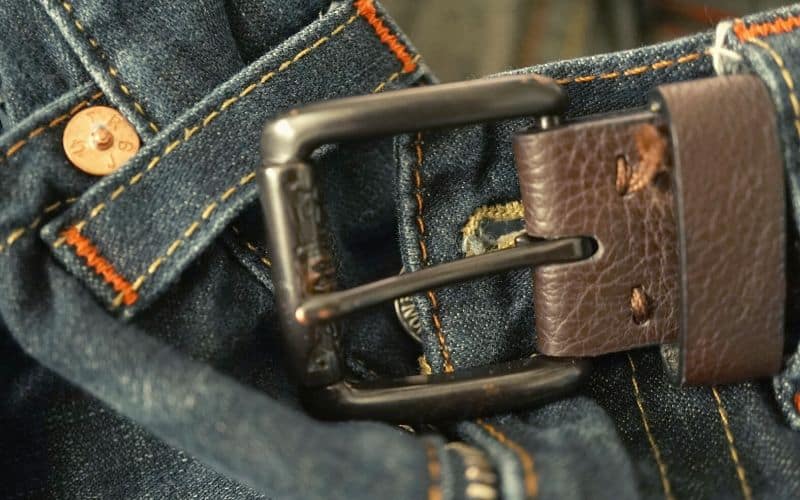
Hooked Buckles
Hooked buckles consist of a hook that attaches to a hole or webbing loop on the other end of the belt. They have become more common on hiking belts in recent years but, in our experience, don’t offer as secure a fastening as other styles.
Having a (potentially) loose hook dangling around your midriff/groin/genitalia also feels like a risk that’s better avoided.
Clamping Buckles
Clamping, or clamp closure, buckles work by threading the fabric through the clamp and then locking the latch in place to provide a reliable hold. This buckle type is excellent for hiking belts because it is both durable and secure. Since they don’t have prongs or teeth that chew on the fabric, they don’t damage the material with each use, making them less likely to fray over time.
Flip-Closure Buckle
Flip-closure buckles are similar to clamp closures. However, instead of clamping down onto the fabric, they use teeth to provide a secure hold. While these are also a good choice for hiking belts, the serrated teeth on the underside cause additional wear and tear on the canvas with repeated use.
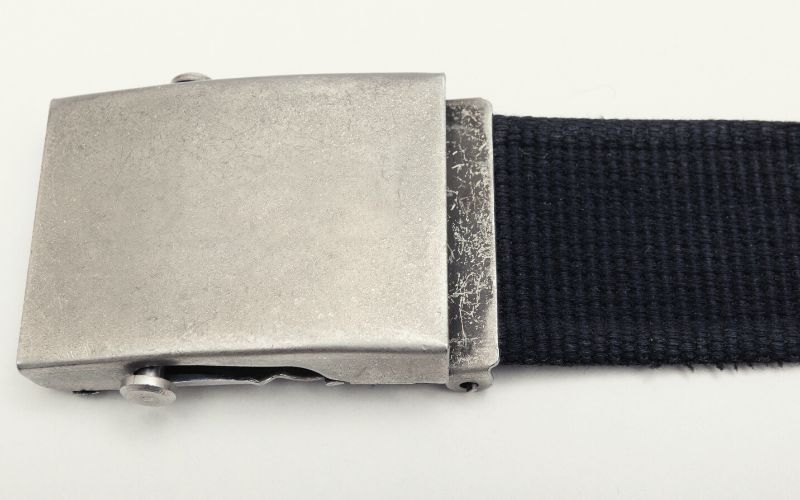
Sliding Latch Buckles
Sliding latch buckles work similarly to a ratchet strap. They have a larger buckle on the front that allows you to “slide” the fabric through as you tighten it. While durable, this buckle style is usually a bit heavier and slightly trickier to use.
Clip-on/Quick-Release Buckles
If ease of use is your primary concern, clip-on or quick-release buckles may be for you. Each end has a piece of the buckle, with one end snapping into the other like a seatbelt. This creates a reliable hold that can be quickly undone either by pushing a button or pinching the sides of the closure, allowing it to snap open quickly.
These belts are marvels of convenience but need to be made from more durable materials to deal with the wear and tear caused by repeated pressure and release. If opting for this style, look for a model made with acetal homopolymer plastic or polycarbonate, both of which have high tensile strength.
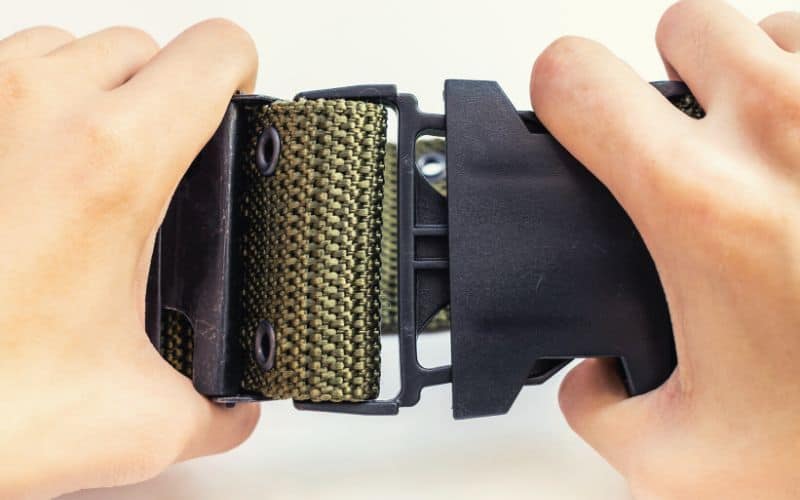
Materials
Like all hiking gear, long-term durability relies on high-quality materials. In the case of belts, the webbing fabric of the belt band and the buckle materials are the most crucial for long-term performance.
Fabric
Outdoor belts are typically made from synthetic fabrics such as nylon or polyester or natural materials such as leather or canvas.
Synthetics like nylon and polyester make up the majority of belts in the niche of hiking pant holders. This is because they’re quick-drying, lightweight, flexible, and, for most, much more comfortable. On the downside, these belts occasionally lack longevity and can dig in at the hips if the material is too rigid or the webbing is too thin.
Leather belts provide outstanding longevity and ruggedness. However, they’re also usually far heavier than synthetic alternatives and take an age to dry when wet. Flexibility and mobility are also key concerns for most hikers, so some leathers might be just a little too stiff to allow the freedom of movement you desire.
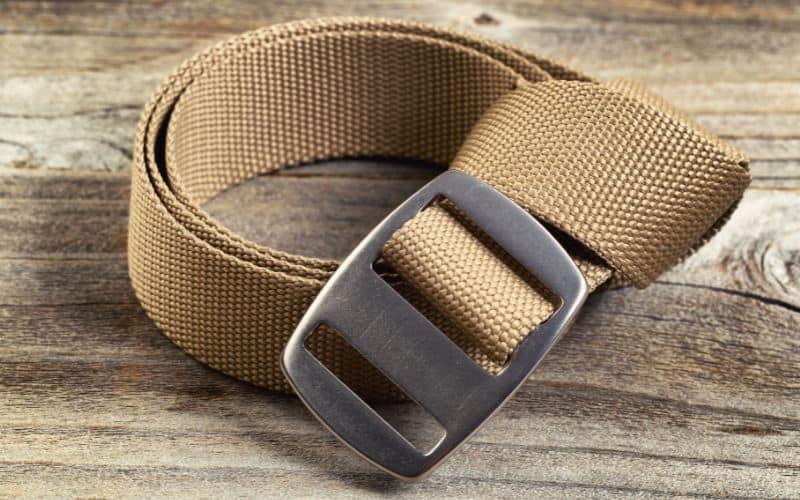
Buckle
Buckles for hiking belts are usually made from metal, plastic, or occasionally even carbon fiber.
Metal buckles made with titanium, stainless steel, and aluminum are strong and the most durable options. Steel models, however, are often a little on the heavy side and not ideal for those who don’t like feeling at all encumbered by their clothing. Plastics and carbon fiber, of course, weigh less and won’t set off the metal detectors at the airport, however, plastic is far easier to break.
Weight
Weight is the key difference between casual or luxury belts and those designed for outdoor use. Ideally, your belt should weigh under 10 ounces. Most outdoor adventurers agree that a lighter belt is better, as long as it doesn’t compromise durability and ruggedness.
Ideally, hiking belts should also have a low profile, especially if you anticipate wearing them under a mountaineering harness. Also, compact and flat buckles won’t be felt under your backpack’s hip strap and are less likely to get caught in your shirt or straps.
Belt length is another important consideration, and this essentially comes down to ensuring your pick is fully adjustable or can be cut to size. To do the latter, you simply remove the buckle, cut the fabric to the desired length, heat seal the fabric with a lighter to prevent fraying, and then replace the buckle.
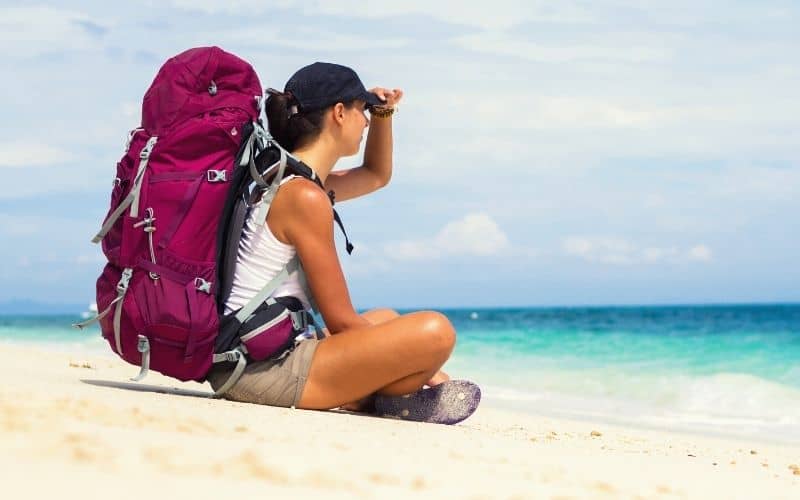
Durability
The ideal belt for backpacking or hiking must be durable enough to handle rough trail conditions. Signs of durability include the use of high-denier fabrics and one-piece buckles that don’t have breakable components. Machine-washable fabrics are also beneficial. Even if you don’t plan on washing your belt all too often, this indicates a belt’s ability to withstand repeated soaking and rough treatment on the trail.
Durability is hard to gauge when buying online, so we recommend reading user reviews from buyers that are made months after the purchase to get a handle on how any model performs in the longer term.
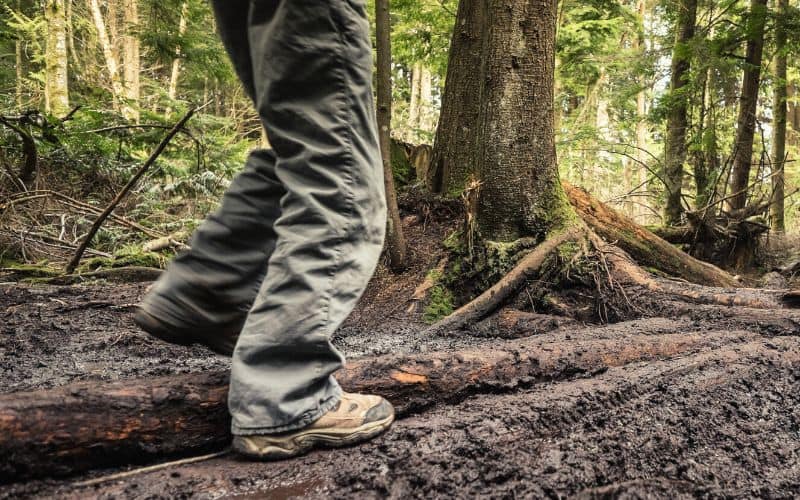
Best outdoors belts for Hiking, Backpacking or Mountaineering: The Verdict
The best belt for outdoor adventures is the Arc’teryx Conveyor. It is ultralight, comfortable, tough, and with a low profile is less likely to snag or get in the way than most other hiking belts on our list.
If the Conveyor’s a little too pricey for your budget, we recommend the Propper Tactical Duty, which boasts more or less the same design as the Conveyor and the Black Diamond Diamond Mine Belt but uses slightly lower-quality materials – and costs a fraction of the price.
So, how did you like our article? If we missed anything or you have any questions, let us know! And if you’d like to share this post with your friends, please do!
